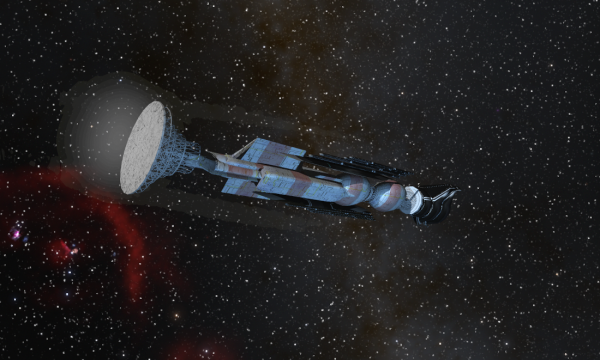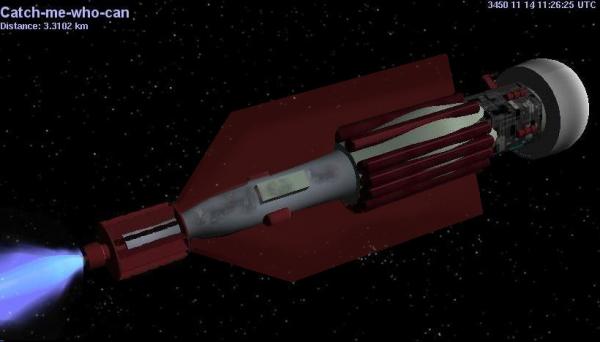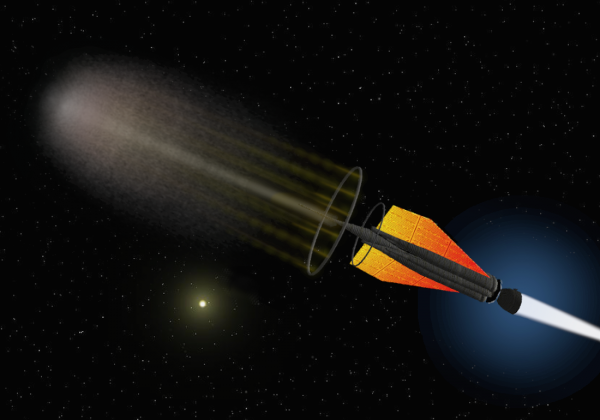BY LETTER
Ship Design: Shielding
Technology > Application > Transportation > Interstellar Transport
Technology > Application > Transportation > Ships
Technology > Application > Transportation > Ships
Protection against radiation and particle collision during interstellar flight | |
 Image from Steve Bowers | |
| A Conversion Drive interstellar spacecraft with a monopole-augmented matter shield which protects against interstellar dust and radiation. Monopole-augmented matter can be more than a hundred times denser than normal matter, so needs considerable structural support. Many interstellar craft of this type use Whipple Shields made of augmented matter, consisting of numerous thin sail-like layers which precede the craft. | |
The Dangers of Impact During Interstellar Flight
Due to the diffuse gas and dust of the interstellar medium (ISM), vessels travelling at even a small proportion of the speed of light (c) must account for the energy released by virtually continuous impact with the ISM, with the danger increasing the closer to c the ship travels. As demonstrated by the relativistic kinetic energy formula:K=mc²(gamma -1), where gamma = 1/sqrt(1-(v/c)²)
At 0.3 c, a one milligram impact will release 4.3456e+09 J of energy, equivalent to one ton of chemical high explosive. At 0.9 c the figure rises to 1.1647e+11 J, and for a ship traveling at 0.99c, 5.4799e+11 J.
Erosion from the Interstellar Medium
Assuming an average density for the interstellar medium of 1 particle per cubic centimeter, at 0.3 c a ship's forward shield will encounter 1E+18 ISM particles per square centimeter per light-year traveled. If each impact displaces 2 atoms from the shield, every light year traveled will cause the loss of 2E+18 atoms per square centimeter. For carbon shields, this is a loss of 40 micrograms per light year per square centimeter. Therefore, a 1 cm thick shield, can survive a voyage of 25,000 light-years before being worn through. At high relativistic velocities however, space-time contraction is significant enough that the effective ISM density increases.Ship Irradiance by Percent of C | |
| 10 | 23 watts/meter² |
|---|---|
| 15 | 78 watts/meter² |
| 20 | 190 watts/meter² |
| 30 | 684 watts/meter² |
| 40 | 1,792 watts/meter² |
| 50 | 4,027 watts/meter² |
| 60 | 8,454 watts/meter² |
| 70 | 17,691 watts/meter² |
| 80 | 40,080 watts/meter² |
| 90 | 120,485 watts/meter² |
| 99 | 1,926,733 watts/meter² |
| 99.9 | 21,526,235 watts/meter² |
| 99.99 | 222,250,621 watts/meter² |
| 99.999 | 2,244,406,372 watts/meter² |
As a result, interstellar ships traveling at velocities above 40% of c are required to use significant shielding. Details of shield design vary, but most shields are disks or dome shapes larger than the cross-section of the main superstructure, thereby providing shadow shielding for the rest of the ship. Radiation shielding is generally considered separate from main shielding, which serves to protect the ship from the heat flux of the ISM.
Types of Shielding
Mass Shielding
Ice and reinforced variants:
 Image from Steve Bowers | |
| The Catch-Me-Who-Can, a First Federation Antimatter Beam Core drive ship with carbon-nanofibre-reinforced ice shielding at the bow | |
Perhaps the most common type of shielding for velocities up to 33.6% of c is ice. The early interstellar missions (Interplanetary Age to Technocalypse) most often employed this material and it still remains in use for slower craft such as the Muuh iceships. Ice has several advantages as a shield material:
1. Occurrence: Ice is naturally abundant, and therefore readily available as a shielding material.
2. Reflow: Ice has a relatively low melting point compared to other shielding materials. When the ISM collides with the shield, the centermost particles tend to only travel a short distance before being redeposited back on the shield. By periodically melting and refreezing the ice, it can be reflowed in order to reverse the erosion built up while in flight. However, particles ejected near the edges of a shield may be lost to space rather than redeposited, causing the edges of an ice shield to erode away over time.
3. Ice can be re-purposed as reaction mass, if necessary.
However, ice is not without disadvantages. It is weaker and heavier compared to other shielding materials, though the first issue can be solved by mixing the ice with wood, carbon fiber, or even carbon nanotubes. This mixture is called pykrete. Past 33.6% of c shield materials begin to transition from ice to carbon shields, though it is not uncommon to see ice shields on short duration trips in higher velocity regimes.
Carbon Shields
Shields made of carbon are widespread due to the material's common occurrence and high sublimation temperature. Carbon nanotube shields are also often used because of its high strength.Past 97.8% of c, carbon shields transition out of use, though like ice shields, is not uncommon to see them on short duration trips at higher velocities.
Utility Gel/Sand Shields
Usually only used at lower velocities where the temperature caused by irradiance is not high enough to melt or vaporize the utility gel/sand. Such shields offer advantages in that they can reconfigure more easily than solid shields and are self-healing. However, their inherent complexity makes them more vulnerable to the heat and radiation of particle impacts. Such active shields are usually withdrawn into holding tanks or reconfigured to protect specific components or ship sections once a vessel reaches velocities where shield attrition outweighs their usefulness.Monopole Augmented Matter:
Monopole Augmented Matter shields came into common usage after the appearance of the Second Singularity high transapients in 1116 AT. Abbreviated as MAM, this type of shield is an intermediate step between conventional matter and magmatter shielding. Massive monopoles are combined with conventional mass shields to augment their density and therefore, protection against the interstellar medium. As protons still make up a significant portion of the shields, they are not as dense as magmatter.MAM shields are heavier than other mass-based shielding methods, except for magmatter. This makes them unsuitable for applications requiring low mass. This continues to make magnetic shields and pathfinder lasers a more common shielding option than MAM by itself. However, these systems require energy to operate while MAM shields do not. MAM shields are effective for all velocity regimes, though like magnetic shields and pathfinder lasers, they are most often seen at velocities between 0.25 c and 0.8 c.
Whipple Shields:
As ship design improves and cruise velocities increase, Whipple shields are often used instead of more monolithic designs due to their greater mass-efficiency. The typical monolithic shield (e.g., ice, MAM) lacks a mechanism to disperse energy from impacts, and as a result cratering is exacerbated.Whipple shields improve on this by separating the shield into multiple layers with gaps (known as standoffs) between them. The first layer is not expected to stop the incoming particle nor remove much of its energy, but rather to break it up and disperse its energy over a larger area. Thus, it is easier for subsequent layers to stop the particle. In some cases, the first layer may indeed remove much of the projectile's energy.
Whipple shield units are actively reconfigured for optimum function as a vessel's velocity increases or decreases - adjusting such parameters as the standoff gap between each layer. Most systems also incorporate magnetic fields into each layer in order to direct the ionized remains of any impactor away from the vessel.
Droplet Shields:
 Image from Steve Bowers | |
| A ship equipped with a Droplet Shield under acceleration. The shield creates a cloud of particles in front of the spacecraft, intercepting dust particles and interstellar hydrogen. The droplets fall back towards the ship and are collected for reuse. The droplet system can also be used for active cooling. | |
For velocities from 35-55% of c, droplet shields are the most effective type of matter-based protection. Droplet shields are composed of liquid metal droplets heated to above their Curie point (The Curie point is the temperature above which certain materials lose their permanent magnetic properties, which can (in most cases) be replaced by induced magnetism.). Droplets are emitted from a series of nozzles at the bow of the ship, and magnetic fields hold the droplets on their intended trajectory. As it can be magnetically manipulated, the droplet shield can be at any distance from the ship's hull. After the droplets begin to cool down to below the Curie point, they are pulled back in by the magnetic field, and are recycled. Inevitably, some droplets will be lost over time as particles impact them, but this is not significant for velocities below 55% of c.
Droplet shields can be also be used as radiators and are one of the most common shielding methods. However, they must be combined with some form of mass shielding as the technology does not protect against high energy radiation. Droplet shields are also relatively more complex.
Dust based variants of the droplet shield are sometimes used, though they are less effective.
Magnetic Shields and Pathfinder Lasers:
Magnetic shields used in combination with pathfinder lasers are one of the most common shielding methods. An array of centimeter-wide laser beams is used to ionize the ISM, while the magnetic field repels the now charged particles away from the ship. To ionize the ISM, an intensity of 0.1 PW/m2 is required for the lasers themselves.Pathfinder lasers can also be used to eliminate larger debris that might endanger the ship. However, if the optics are impacted by particles, they will degrade and erode, although only if the magnetic shield fails to repel the charged particles. As with droplet shields, this system does not provide any protection from high-energy radiation, though the required radiation shielding mass is very low. These shields are effective for essentially any velocity regime.
Monopole Augmented Magnetic Field Generation:
While the field strength requirements of magnetic shields operating in the middle velocities for interstellar travel are quite high, this is not much of a concern due to superconducting materials and magnetic monopoles, used in combination to produce the necessary field strengths. The energies contained in the magnetic field are considerable, but reduce significantly as velocity increases — for example, because magnetic fields have an energy density of close to 400 kJ/m^3 times the square of the field strength in tesla, the field strength of 9350 T for a magnetic shield operating at 40% c means that there are 34.96 Terajoules per cubic meter of space where that field exists. At 70% of c there are 0.5 Terajoules per cubic meter. Because monopoles are being used to produce the magnetic field, the field will extend farther than with a current loop - falling off at 1/r^2 rather than 1/r^3.All containment designs for magnetic monopoles must account for their mutual repulsion, otherwise they will scatter. If the containment of the monopoles fails, the energies released will destroy most, if not all, of the ship.
Monopole-based magnetic field generators are less energy-efficient and riskier than magnetic shields and ionizing lasers in terms of the containment process, and so the latter are far more common. Furthermore, magnetic shield and laser systems can easily adjust their output, unlike a monopole-based magnetic shield. However, a monopole-based system is also desirable for that same reason — it will continue to work even without a supply of electricity.
Godtech Shielding
Void Bubble Shielding:
Void bubble shielding becomes available at the Fifth Singularity and above and comes in two main types.1. 'Built-in' Magnetic Shielding
As both Class I and Class II halo drives utilize magnetic coupling to drive the ship, these magnetic fields can also be re-purposed to act as a magnetic shield. The generators themselves are essentially invisible, hidden away in the void bubbles.Since void bubbles are larger on the inside than the outside, massive magnetic field generators can be used while the exterior dimensions of the void bubble remain in the picometers to tens of nanometers range. Note that Fifth Singularity void bubbles can also operate in a nested configuration, further increasing the field strength that can be produced as long as overall mass does not become so high in comparison to the exterior dimensions of the void bubble that an event horizon is formed.
The mass limit for a 1 picometer radius bubble is 1.49e15kg so magnetic shield generators massing up to billions of tons can be used.
.png) Image from Steve Bowers | |
| This sighting of a Halo Drive ship was preceded by an area of metric distortion, believed to be a gravitational shield of some kind. | |
2. Gravitational Diversion Shielding
Also known as Metric Shielding. Void bubbles can also be used in a variant of halo technology to divert particles and macroscopic quantities of matter from ever hitting a ship through gravitational action. In most cases, the gravitational diversion is not enough to fully protect the ship and merely augments other more conventional protective systems.Void bubble shielding systems can be used individually or in combination, depending on ship design.
Void Ships:
What little has been observed of void ships suggests that the outermost void bubble of such vessels acts as a built in shield, diverting away particles from ever hitting the ship itself. The small cross-section of void ships (~1000nm diameter) also make the odds of interacting with the interstellar medium or the occasional macroscopic obstacle extremely low.
Related Articles
Appears in Topics
Development Notes
Text by (Original article by M. Alan Kazlev, Mauk Mcamuk, Chris Shaeffer, suggestions by Anders Sandberg and Xaonon)
Updated by Everything4404 - 31 October 2020
Initially published on 02 February 2001.
Special Thanks to:
ToughSF and the ToughSF Community
Updated by Everything4404 - 31 October 2020
Initially published on 02 February 2001.
Special Thanks to:
ToughSF and the ToughSF Community






